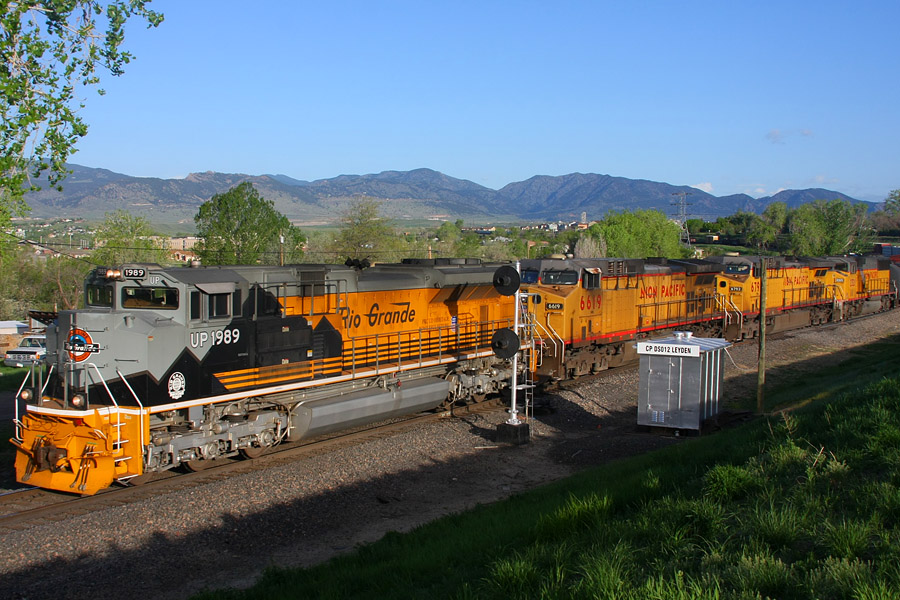
It is with great sadness that I report that the
Ski Train has been sold and will no longer operate in Colorado.
I'll let that sink in for a moment. The last remaining standard gauge operation that was truly a Rio Grande original is now gone. Started by the Denver and Rio Grande Western in 1940 as a means of getting the residents of Denver to their city-owned Winter Park ski area, the train operated over 69 seasons. It originated at Denver's Union Station and dropped skiers off for a day of skiing after emerging from the Moffat Tunnel, just 12 years old in 1940. The train would be wyed at Tabernash and wait in the siding at Frasier until the day came to a close, when it would return to the same curve and pick up happy and tired skiers for a relaxing ride home.
In 1984, Denver businessman Phil Anschutz purchased the Rio Grande and then in 1988, purchased the Southern Pacific Railroad (SP), merging the two under the larger railroad's name. As part of the deal, a subsidiary of Anschutz Company would buy the Ski Train and operate it as a separate venture. They continued losing some money in the venture, but it was something they "wanted to do," according to company spokesman Jim Monaghan.
As for the reasons leading to the sale of the historic train, it was a combination of things. Monaghan cited four problems faced by the Ski Train, in no specific order.
- overall cost increases, particularly for liability coverage
- operating issues with freight trains over the route owned by SPs successor, the Union Pacific railroad
- uncertainty surrounding the redevelopment of Union Station and the Ski Train's place in that development (I blogged about this here)
- a weakened overall economy
While no control can be exerted over issues 1 and 4, issues 2 and 3 should have been mitigated or resolved before the sale became an option. One could wonder if issue 2 was a monster of Anschutz's own making when the company sold SP to Union Pacific in 1996. The Union Pacific is no lover of passenger trains, as riders of Amtrak over the years can readily attest to. By losing ownership of the route, Anschutz lost control of whose trains get priority treatment. Additionally, recent maneuvers by the Obama administration and a Democrat-controlled congress have put pressure on the Big Four railroads to make Amtrak trains on their routes a priority, resulting in better on-time performance for Amtrak. This is all well and good, but could this well-intentioned maneuver by the government have lead to the California Zephyr taking the Ski Train's priority ranking over the crowded Moffat Route? It's a logical possibility, as the Amtrak effort coincided with the end of the 2009 Ski Train season. The sad irony is that by pushing state-sponsored trains, Obama and company are sending the capitalist private-sector trains to the scrap yard or, in this case, out of the country.
Issue 3
appeared on this blog back in January. As I said in the post,
RTD feels a "social obligation" to it, but that's different than a contractual obligation. Where do the skis, poles, boots and people go if the platforms are spoken for by the local commuter train to Brighton? Putting more cars on I-70/US 40 to Winter Park is not an option.
Now it appears that the non-option is the
reality. Since the RTD announced plans for redeveloping Denver's Union Station, they never publicly specified where the Ski Train would fit in the plans. Translation: The Ski Train is not welcome. The cars on the pavement in Denver are now being moved to the mountains by the neglect of an agency designed to improve transportation in Denver. Parasite or patron, Denver has historically shown that it is for Denver's cause above that of Colorado in general, and this fits right in.
This is indeed sad news. At the age of 69, a wonderful train is being sold off, with no replacement in sight.
HT: Kevin Morgan
 although the turntable pit location is masked by the parking lot. It's good to see the building retain its appearance and character while remaining useful and functional.
although the turntable pit location is masked by the parking lot. It's good to see the building retain its appearance and character while remaining useful and functional.





